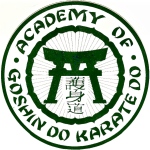Here’s a dirty little secret. Martial artists, karate practitioners and even my circle of Goshin-Do colleagues may disagree with what follows.
Bunkai, a Japanese term for the analysis of kata, is a closely guarded secret of karate practitioners. For a price (seminar fees, videos, books, etc) the purse strings around the secrets of bunkai can be loosened. So what is the dirty little secret about kata analysis?
Simple.
Anyone, even those without five minutes of traditional karate lessons, can engage in kata analysis. Bunkai is for anyone.
How? First you need to know a kata. A fortiori, anyone can and should acquaint themselves with Sanchin Kata for free right here on this blog. Link: https://senseijohn.me/sanchin-book/
Next, you need to understand what bunkai is. Karate practitioners often mistakenly define the term bunkai as the practical self-defense applications of kata movements. This is limited and wrong. Bunkai is defined as “analysis.” Karate practitioners, to their detriment, limit their analysis of kata solely to the practical applications of the self-defense techniques within the kata movements.
It is my goal to broaden the concept of kata bunkai to include omitted aspects of analysis. In their bunkai practice, martial artists tend to ignore two fundamental aspects of kata. These aspects are the spiritual aspect of kata (the manner in which kata affects your mental, psychological and emotional state) and the metaphysical aspect (the manner in which kata connects you to the environment).
My non-martial artist readers can readily appreciate the value of kata analysis beyond the physical analysis of kata.
In my over four decades of karate-do, I have observed the application of time spent on kata bunkai (analysis) by martial artists is roughly:
- Physical bunkai – application of self-defense technique within kata movements – 88%
- Spiritual bunkai – the aspect of the ritual that is kata (how it affects our mind and emotions) – 7%
- Environmental bunkai – the manner in which our environment affects kata and kata affects the environment – 5%
Those non-martial arts readers that avail themselves of my free Sanchin, can engage in analysis from an entirely different perspective. The time spent on such analysis would downplay the self-defense application and emphasize the remaining two aspects. Further, once a karate-ka (practitioners) have sufficiently studied the physical aspects of kata bunkai, they must expand their study. It might look something like this:
- Physical bunkai – application of self-defense technique within kata movements – 5% (mostly from curiosity in the case of a non-martial artist; for karate-ka, this is to maintain a “sharpened-sword”)
- Spiritual bunkai – the aspect of the ritual that is kata (how it affects our mind and emotions) – 50%
- Environmental bunkai – the manner in which our environment affects kata and kata affects the environment – 45%
I’ll post future submissions to illustrate the idea that anyone can perform kata bunkai (analysis) and guide the non-martial arts reader through the process.
Featured Video:
Until, then, I remain ,
Sensei John Szmitkowski
If you enjoy Sanchin and the accompanying analysis of Sanchin, please help support this blog, visit my store.
Come visit my store on CafePress!
For a refreshing and innovative discourse on kata and bunkai, please feel free to visit Sensei John’s Kata Laboratory and “THINK * SWEAT * EXPERIMENT” using this convenient link: https://senseijohn.me/category/kata-laboratory/
Sensei John is now on Facebook, under – FLY FISHING DOJO, you are invited to send a Facebook friend request.
You may wish to view my other blogs –
 My fishing blog that is dedicated to the interrelationship between martial arts protocol & ideology to fishing http://flyfishingdojo.com
My fishing blog that is dedicated to the interrelationship between martial arts protocol & ideology to fishing http://flyfishingdojo.com
and
 the Goshin-Do Karate blog at http://defeliceryu.com
the Goshin-Do Karate blog at http://defeliceryu.com



YOUR COMMENTS ARE WELCOME